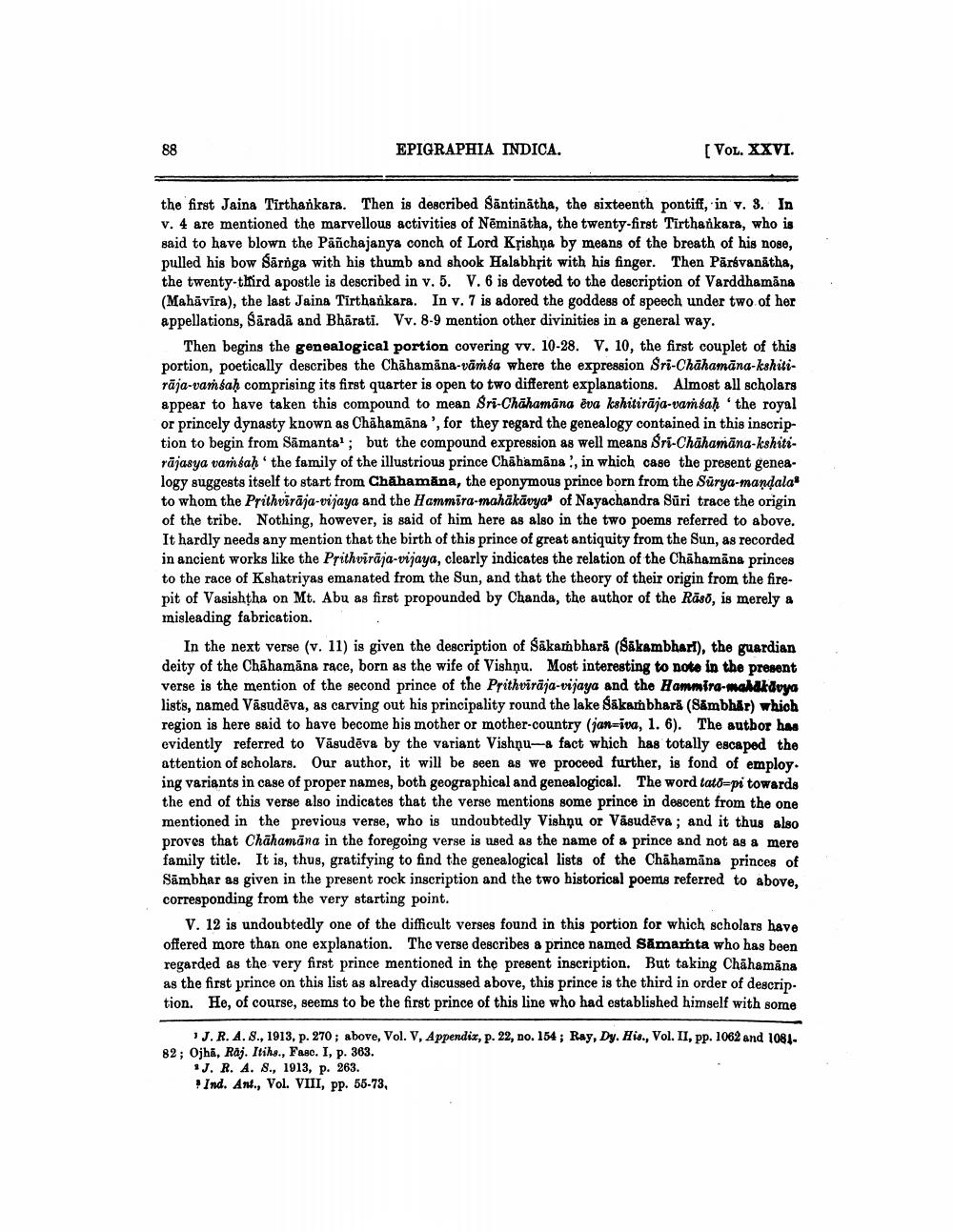________________
EPIGRAPHIA INDICA.
[VOL. XXVI.
the first Jaina Tirthankara. Then is described Sāntinātha, the sixteenth pontiff, in v. 3. In v. 4 are mentioned the marvellous activities of Nēminātha, the twenty-first Tirthankara, who is said to have blown the Pañchajanya conch of Lord Krishna by means of the breath of his nose, pulled his bow Sāroga with his thumb and shook Halabhpit with his finger. Then Pārsvanátha, the twenty-third apostle is described in v. 5. V. 6 is devoted to the description of Varddhamana (Mahāvīra), the last Jaina Tirthankara. In v. 7 is adored the goddess of speech under two of her appellations, Sāradā and Bhārati. Vv. 8-9 mention other divinities in a general way.
Then begins the genealogical portion covering vv. 10-28. V. 10, the first couplet of this portion, poetically describes the Chāhamăna-vámea where the expression Sri-Chāhamāna-kshitirāja-vamsah comprising its first quarter is open to two different explanations. Almost all scholars appear to have taken this compound to mean Sri-Chāhamāna ēva kshitirāja-vaṁsah 'the royal or princely dynasty known as Chāhamāna ', for they regard the genealogy contained in this inscription to begin from Samantal; but the compound expression as well means Sri-Chāhamāna-kshitirājasya vambah the family of the illustrious prince Chāhamāna , in which case the present genea. logy suggests itself to start from Chāhamăna, the eponymous prince born from the Sürya-mandala to whom the Prithvirāja-vijaya and the Hammira-mahākāvya of Nayachandra Sūri trace the origin of the tribe. Nothing, however, is said of him here as also in the two poems referred to above. It hardly needs any mention that the birth of this prince of great antiquity from the Sun, as recorded in ancient works like the Prithvirāja-vijaya, clearly indicates the relation of the Chāhamāna princes to the race of Kshatriyas emanated from the Sun, and that the theory of their origin from the firepit of Vasishtha on Mt. Abu as first propounded by Chanda, the author of the Rāso, is merely & misleading fabrication.
In the next verse (v. 11) is given the description of Sākambhară (Sakambhart), the guardian deity of the Chāhamāna race, born as the wife of Vishņu. Most interesting to noto in the present verse is the mention of the second prince of the Prithvīrāja-vijaya and the Hammira-mahdkdvya list's, named Vāsudēva, as carving out his principality round the lake Sākambhară (Sambhar) which region is here said to have become his mother or mother-country (jan-iva, 1. 6). The author has evidently referred to Vāsudēva by the variant Vishnu-a fact which has totally escaped the attention of scholars. Our author, it will be seen as we proceed further, is fond of employ. ing variants in case of proper names, both geographical and genealogical. The word tato=pi towards the end of this verse also indicates that the verse mentions some prince in descent from the one mentioned in the previous verse, who is undoubtedly Vishņu or Väsudēva; and it thus also proves that Chāhamāna in the foregoing verse is used as the name of a prince and not as a mere family title. It is, thus, gratifying to find the genealogical lists of the Chāhamana princes of Sambhar as given in the present rock inscription and the two historical poems referred to above, corresponding from the very starting point.
V. 12 is undoubtedly one of the difficult verses found in this portion for which scholars have offered more than one explanation. The verse describes a prince named Sāmamta who has been regarded as the very first prince mentioned in the present inscription. But taking Chāhamāna as the first prince on this list as already discussed above, this prince is the third in order of descrip. tion. He, of course, seems to be the first prince of this line who had established himself with some
IJ.R.A. 8., 1913, p. 270 ; above, Vol. V, Appendix, p. 22, no. 154 ; Ray, Dy. His., Vol. II, pp. 1062 and 108182; Ojhā, Raj. Itihs., Fasc. I, p. 363.
1J. R. A. s., 1913, p. 263.
Ind. Ant., Vol. VIII, pp. 55-73,




